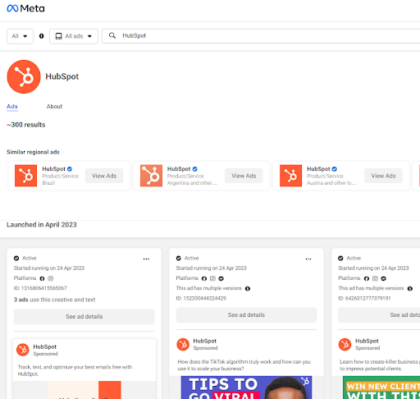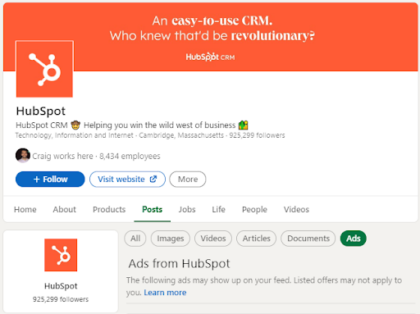[ad_1]
Typically, B2B organisations neglect paid social media advertising as it can sometimes be regarded as an upper funnel channel or one that lacks the ability to drive pipeline-focused intent.
Here’s why that’s not always the case, and why paid social media is essential for a coherent, multi-channel marketing strategy in the B2B marketing landscape.
What is paid social media advertising?
Paid social media advertising is a form of digital marketing where you pay to have your content displayed on social media platforms to reach a specific target audience.
This type of paid media allows advertisers to promote their products or services to a broader audience beyond their existing followers or customers.
Social media platforms such as Facebook, Instagram, Twitter, LinkedIn, and Pinterest offer advertising options for businesses and individuals to create and promote their ads.
You can target specific demographics such as age, location, interests, behaviours, and more to ensure your ads reach the right audience.
These ads can take many forms, including sponsored posts, promoted tweets, display ads, video ads, and influencer marketing.
The cost of paid social media advertising varies depending on the platform, target audience, ad format, and duration of the campaign.
Advertisers can also set a budget and bid for ad placements based on their desired target audience and campaign objectives.
The best platforms for finding B2B audiences
With over 65 million companies in over 200 countries, LinkedIn is a pivotal resource in your arsenal for reaching relevant – business to business – audiences.
Its ability to include Job, Company, and Skill based targeting means you can quickly and efficiently find the right audiences.
Meta
Meta also has over 200 million businesses active on the platform, and almost 3 billion daily users.
Whilst often seen as a procrastinator’s paradise and an awful platform to drive high-quality leads, it has recently stepped up its ability to target B2B audiences, with Job and Company industry refinements.
It’s also a much cheaper channel to activate retargeting, compared with LinkedIn, provided you already have the custom audience data.
Quora
With 600+ million monthly viewers, and over 1 million questions in the Business category, there is a reason that over 60% of advertisers on Quora are B2B.
Quora is often an overlooked platform, and whilst it doesn’t necessarily offer ‘sexy’ paid social marketing, it is a very useful tool that can be used to convert low-mid level intent users into high-intent converters, by providing relevant educational marketing.
YouTube
With 46% of B2B tech buyers purchasing a product or service after viewing video content, it’s not surprising that YouTube advertising ranks as the 4th most valued social platform for B2B marketers.
Often avoided due to its rich media and upper funnel presence, YouTube is fast becoming a favoured platform for B2B marketers given its recent switch to a more Direct Response-focused offering. Direct Response marketing is designed to elicit an immediate action like submitting a lead or completing a conversion (not just watching a video).
With access to traditional paid channels, why incorporate paid social?
“Traditional” B2B paid media channels are often reliant on pre-existing data, intent, or extremely comprehensive reporting in place to show success.
- Search: Typically relies on intent (in some way) already being present
- Display: Can be difficult to measure without relying on post-impression-only data
- Email: Requires first-party data to already exist at scale
You’re relying on a user already having something, or you have the ability to measure something here. It’s very difficult to create or nurture net new intent solely using the above channels.
Integrating paid social would allow you to take up a full-funnel approach whilst still including these traditional B2B channels, building the intent, and data, and bridging a gap in post-click and post-impression data that the above cannot do alone.
What are the key things paid social can do for B2B audiences?
1. Branding and awareness
Paid social can be used in a way that some of the aforementioned traditional B2B channels cannot. It can be used to build and create intent.
Whilst display can utilise 3rd party audience data, it often is either expensive to use or can lack the accuracy of LinkedIn’s Walled Platform data.
2. Lead generation
Paid social isn’t just a fluffy branding channel – when used correctly for B2B it can be a well-oiled lead generation machine.
3. Lead and prospect nurturing
Stay front of mind with potential pipeline prospects by serving relevant, positively reinforcing content.
Forgetting about leads after they hit your pipeline is a surefire way to see your close rates drop.
By offering relevant, positive reinforcement to clearly in-market customers (perhaps case studies, client testimonials, award wins, offers, etc.) then you’re building a much stronger chance of converting.
4. Account-Based Marketing (ABM)
Successful Account-Based Marketing (ABM) always integrates social, to provide the visual, emotional connections needed to drive 1:1, personalised conversations with sales teams.
The B2B funnel is much more complex than a standard customer journey, as highlighted by Gartner:
This is why it’s important to provide as many touch points as possible – and using paid social is an extremely effective way to do so.
Paid social shouldn’t be used to try and simplify the customer journey, from the first impression through to the purchase decision. We ultimately know the channel is working if we’re able to reduce the gap between awareness and enquiry.
B2B social considerations
A few things to consider when you are running B2B social media campaigns:
Gated content is the champion of B2B lead generation and lead nurturing
Gated content is a severely under-utilised aspect of paid social, and B2B in general. Most advertisers either give away their assets for free, or they ring fence everything on deep dark hidden areas of their website.
Use that content, and leverage it to drive engagement with your target audiences. Potential customers are going to be far more willing to provide you with their data if there’s an incentive/reason.
One size most definitely does not fit all
Taking a one size fits all approach to your;
- Messaging
- Audience
- Product
- Level of Intent
This will ultimately mean your campaign isn’t tailored to the right audiences at the right time.
Understand who your competitors are, even if you assume they aren’t relevant
So often I hear “they aren’t our direct competitors” or “we offer something slightly different to them”. I hate to say it, but if you’re competing for ad space and inventory in your target users’ attention span – they’re a competitor.
It’s now easier than ever to understand what ads your competitors are running on both Meta and LinkedIn using the Meta Ads Library, or reviewing Paid Ads on a LinkedIn company profile.


Always have a purpose, and never jump in at the deep-end
Too often we see clients coming to us and asking us to run a ‘lead generation’ campaign with no nurturing, no awareness, and no education segment. Would you buy a house without looking at it first? Or even knowing you needed a new house? It’s unlikely, isn’t it.
The same can be said for B2B – people often don’t know what they don’t know, and more often than not, starting your campaigns at the cold sale is going to be a waste of media spend.
Your upper and mid-funnel activity can always have a purpose, and even a secondary purpose – so you can understand and differentiate the success at different elements of the funnel:
- Driving upper funnel awareness should have a purpose. Branding for the sake of branding is irrelevant. Build audiences from your branding that are ‘warm’ and qualified.
- The same can be said for the opposite end of the sales cycle. Jumping straight in at demo and sales stage is a surefire way to burn media spend. You need to warm users over time.
A good paid social media strategy for B2B should essentially work as an endless cycle of awareness, fuelling soft-gated content, fuelling high-intent lead generation, fuelling nurturing and so on.
International B2B social considerations
If your user journey is messy and unclear, you risk damaging your campaign’s potential.
Serving ads in a language that doesn’t match your campaign’s targeting, or more importantly, your landing page will mean your conversion rates will be almost nonexistent.
Yes, some regions are multilingual, but for the user experience, try and understand how a disconnect between browser/surfing language and landing page language can be a shock to the system.
Also, consider your sales pipeline process – does it have native language support?
Traditional networks may not have the same reach as region-specific platforms
Everyone likely assumes that LinkedIn is the predominant platform for B2B targeting, but in the DACH regions (Germany, Austria and Switzerland), using Xing will likely see you access a similar portion of the market (14%).
Whilst this has been changing recently, there are still specific, market-related nuances that are hugely important to be aware of.
Many countries tend to see varying adoption rates of social media, with Whatsapp and other messaging social platforms seeing greater traction in Europe, Asia and Africa.
The important point here is to ensure that your strategy is cohesive enough to encompass different channels. A wider testing strategy is key.
Don’t assume it will be a quick, easy, or cheap process to scale your brands internationally
If it was an easy, quick, or cheap process to scale your brand internationally, everyone would do it.
Understanding market-specific nuances, and having a clear strategy ahead of time is a good way to prepare your business to launch in a new region – but even that doesn’t guarantee success.
So many brands have tried, and failed, at internationalising. Always consider and balance the risk with the reward.
Paid social is a fantastic channel to use to gain a significant foothold in a market quickly, but it will definitely need support from search and your wider sales teams to make it a sustainable long-term success.
Never underestimate the power of testing
I don’t think I could ever write a blog without shouting about testing. It’s more important than ever when launching into places that you typically have little data on.
Build your tests, be ready to experiment, and always (as I said earlier) have a purpose and goal, along with a clear expectation, so you can gain real-world data to inform your next test.
Paid social is only as good as the channels supporting it
Relying solely on a single channel may yield short-term benefits, but for true growth and a strong presence in international markets – especially in such competitive B2B markets – you need to layer in organic, CRO, and other paid media channels for success.
Want a hand implementing paid social into your marketing strategy? Get in touch.
[ad_2]
Source link









